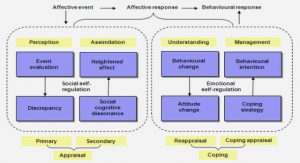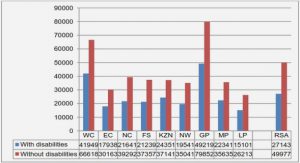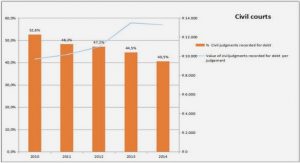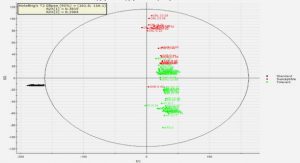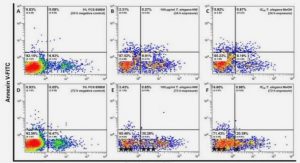Get Complete Project Material File(s) Now! »
Chapter 3 Materials and methods
The objectives of this study were achieved by means of the following procedures:
Soil samples
Eight soil samples of approximately 50 g each were collected in 2003 in plastic sample bottles from a site in Free State Province (Samples 1-8 in Table 1). Soil samples 1 and 3-7 were collected from unpolluted and polluted top soil in the presence and absence of Elusine coracana and Brantha serratia plants (Table 1). Samples 2 and 8 were collected at different depths and were known to be polluted with diesel (Table 1). Samples taken from below the soil surface were collected using a soil auger. A further nine soil samples of approximately 50 g each from a pitch/oil/diesel/petrol/tar-polluted site in Mpumalanga Province were collected from approximately 5cm below soil surface in plastic sample bags in February 2004 (Samples 10-18 in Table 1). Soil samples at site 2 were polluted with different PAH-containing compounds and were rhizosphere and non-rhizosphere associated. Soil samples were taken either within the root zone or approximately 10 cm away from plant roots for rhizosphere and non-rhizosphere samples, respectively. The samples were transported to the laboratory and maintained at 4 ºC until total DNA could be extracted (max. 24 h). All soil samples were taken according to the simple random sampling protocol described by Tan (2005), and are considered to be representative of the environments from whence they came. However, broader spectrum sampling according to acknowledged systematic sampling protocols following standard operating procedures should be followed in soil sample collection in the future. A predetermined samlping area, having the same history, soil texture, colour and slope, should be targeted in a random zig-zag pattern and at least 20 samples collected (Zhang 2003).
Bacterial isolates
Eight bacterial isolates, representing the dominant culturable taxa from the rhizosphere of weeds and from non-rhizosphere soil at site 2 in Mpumalanga Province, South Africa, with a ca. 10-year history of total coal-derived petroleum hydrocarbon pollution, were obtained in pure culture (Molobela 2005). The isolates from polluted soils were randomly designated SA1, SA2 and SA3 from Bidens pilosa L. rhizosphere, SA4 and SA8 from Eleusine coracana (L.) Geartn. rhizosphere, SA6 and SA7 from Cyperus esculentus L. rhizosphere, and SA5 from non-rhizosphere soil.
DNA extraction
Total soil DNA was extracted directly from soils samples using the BIO101 Fast DNA Spin kit (Soil) (Qbiogene Molecular Biology Products). DNA was maintained at –20 ºC at the Department of Microbiology and Plant Pathology, University of Pretoria, South Africa.
Polymerase chain reaction
16S PCR
A portion of 16S bacterial gene of the rDNA was amplified by means of PCR from the total extracted soil DNA, using the primers:
K: PRUN518r: 5’ATT-ACC-GCG-GCT-GCT-GG3’ (Siciliano et al. 2003)
M: pA8f-GC: 5’CGC-CCG-CCG-CGC-GCG-GCG-GGC-GGG-GCG-GGG-GCA-CGG-GGG-GAG-AGT-TTG-ATC-CTG-GCT-CAG3′ (Fjellbirkeland et al. 2001)
These primers were found to be valuable in molecular ecological and systematics studies focussing on the 16S rRNA gene (Øvreås and Tosrvik 1998). Authentic Escherichia coli DNA (courtesy Dr A.K. Drønene) and a reaction with no template DNA were included as positive and negative controls, respectively. Each PCR tube contained a total volume of 50µl: 40.75µl sterile distilled MilliQ water, 5µl PCR buffer with MgCl2 (10x), 2µl dNTPs (2.5µM), 0.5µl primer K (50µM), 0.5µl primer M (50µM), 1µl template DNA (27ng µl-1), 0.25µl hot start Taq (5U µl-1). DNA amplification was performed in a PCR thermal cycler using the following programme: 10 min. at 95 °C, 35 cycles of 30 s at 94 °C, 30 s at 51 °C and 1 min. at 72 °C, followed by 10 min. at 72 °C, and then held at 4 °C. The PCR product was analysed on a 1 % TAE (40mM Tris, 20mM acetic acid, 1nM EDTA (pH 8.3)) agarose gel.
16S rDNA colony PCR
The 16S bacterial gene of each isolate was amplified by means of colony PCR, using the following primers:
K: PRUN518r: 5’ATT-ACC-GCG-GCT-GCT-GG3’ (Siciliano et al. 2003)
M: pA8f-GC: 5’CGC-CCG-CCG-CGC-GCG-GCG-GGC-GGG-GCG-GGG-GCA-CGG-GGG-GAG-AGT-TTG-ATC-CTG-GCT-CAG3′ (Fjellbirkeland et al. 2001)
The M primer was designed specifically for DGGE analysis, hence the GC-clamp for stability. However, these primers were also used in PCR amplification and sequencing of the pure cultures.
A reaction with no template DNA was included as negative control. Each PCR tube contained a total volume of 25µl: 18.7µl sterile water, 2.5µl PCR buffer with MgCl2 (10x), 2µl dNTPs (2.5µM), 0.5µl primer K (50µM), 0.5µl primer M (50µM), 0.5µl 10-1 bacterial suspension, 0.3µl Taq (5U µl-1). DNA amplification was performed in a PCR thermal cycler using the following programme: 10 min. at 95 °C, 40 cycles of 30 s at 95 °C, 30 s at 54 °C and 2 min. at 72 °C, followed by 10 min. at 72 °C, and then held at 4 °C. The PCR product was analysed on a 1 % 1x TAE agarose gel.
Internal transcribed spacer sequence PCR
A portion of the internal transcribed spacer (ITS) gene sequence of the DNA from each samples was subjected to PCR using the primer set:
ITS1 : 5’CAT CGA GAA GTT CGA GAA GG3’
ITS4 : 5’TAC TTG AAG GAA CCC TTA CC3’ (White et al. 1990)
A reaction with no template DNA was included as negative control. Each PCR tube contained a total volume of 25µl: 18.7µl sterile SABAX water, 2.5µl PCR buffer with MgCl2 (10x), 2.0µl dNTPs (2.5µM), 0.5µl primer K (50µM), 0.5µl primer M (50µM), 0.5µl template DNA (27ng µl-1), 0.3µl hot start Taq (5U µl-1). DNA amplification using the K and M primers was performed in a PCR thermal cycler using the following programme: 10 min. at 95 °C, 35 cycles of 30 s at 95 °C, 30 s at 54 °C and 2 min. at 72 °C, followed by 7 min. at 72°C, and then held at 4 °C. DNA amplification using the ITS primers was performed in a PCR thermal cycler using the following programme: 1min. at 92 °C, 30 cycles of 1min. at 92°C, 1min. at 50 °C and 1min. at 72 °C, followed by 5min. at 72 °C, and then held at 4 °C. PCR products were analysed on a 1 % TAE agarose gel.
xylE and ndoB gene fragment PCR
A ca. 400bp fragment from the xylE gene encoding catechol 2,3-dioxygenase, responsible for aerobic aromatic metabolism, from the Pseudomonas putida (ATTC 23973) TOL plasmid was amplified by means of PCR from soil DNA extracted above, using the primers:
Tol1 : 5’GTG-TCT-ATC-TGA-AGG-CTT-GG3’
Tol2 : 5’ATA-GAA-ACC-GAG-CAC-CTT-GG3’ (Milcic-Terzic et al. 2001)
A ca. 650bp fragment from the ndoB gene encoding naphthalene dioxygenase from P. putida (ATTC 17484) was amplified by means of PCR from soil DNA, using the primers:
Nah1 : 5’CAC-TCA-TGA-TAG-CCT-GAT-TCC-TGC-CCC-CGG-CG3’
Nah2 : 5’CCG-TCC-CAC-AAC-ACA-CCC-ATG-CCG-CTG-CCG3’ (Milcic-Terzic et al. 2001)
A reaction with no template DNA was included as a negative control. Each PCR tube contained a total volume of 25µl: 16.7µl sterile water, 2.5µl PCR buffer with KCl (10x), 2µl MgCl2 (25mM), 2µl dNTPs (2.5µM), 0.5µl primer Tol/Nah 1 (50µM), 0.5µl primer Tol/Nah (50µM), 0.5µl bacterial suspension (104cells ml-1), 0.3µl Taq (5U µl-1). DNA amplification was performed in a PCR thermal cycler using the following programme: 3 min at 95 °C, 40 cycles of 45 s at 94 °C, 45 s at 52 °C and 2 min. at 72 °C, followed by 5 min. at 72 °C, and then held at 4 °C. PCR product was cleaned by transferring the entire volume to a 0.5ml Eppendorf tube, adding 2µl of 3M sodium acetate and 50µl 95 % ethanol, and allowing it to stand on ice for 10 min. The suspension was centrifuged at 10 000 rpm for 30 min, the ethanol solution removed and the pellet rinsed in 150µl 70 % ethanol. After further centrifugation at 10 000rpm for 5 min, the ethanol was aspirated and the pellet dried under vacuum for approximately 10min. Following this, the pellet was resuspended in 20µl sterile deionised water. PCR product was analysed on a 1.6 % 1x TBE (89mM Tris, 89mM boric acid, 2mM EDTA (pH 8.0)) agarose gel.
xylE and ndoB gene fragment colony PCR
A 404bp fragment from the xylE gene encoding catechol 2,3-dioxygenase from the P. putida (ATTC 23973) TOL plasmid, and a 641bp from the ndoB gene encoding naphthalene dioxygenase from P. putida (ATTC 17484), were amplified by means of colony PCR from isolated species, according to the method and primers described in 3.4.4. A volume of 0.5µl bacterial suspension (104 cells ml-1) was used as a template for PCR, after which the product was analysed as above.
nifH PCR
A portion of the nifH gene involved in nitrogen fixation was selectively amplified by means of nested-PCR from the total extracted soil DNA and from bacterial colonies, using the degenerate primers:
nifH (Forward A) : 5’ GCIWTITAYGGNAARGGNGG 3’
nifH (Forward B) : 5’ GGITGTGAYCCNAAVGCNGA 3’
nifH (Reverse) : 5’ GCRTAIABNGCCATCATYTC 3’
(Widmer et al. 1999)
DNA sequence degeneracies are depicted using the International Union of Pure and Applied Chemistry Conventions (Liébecq 1992):
R : A/G
Y : C/T
W : A/T
V : A/C/G
B : C/G/T
CHAPTER 1 INTRODUCTION
CHAPTER 2 LITERATURE REVIEW
2.1 Introduction
2.1.1 The fossil fuel industry in South Africa
2.1.2 Soil health
2.1.3 Pollution
2.1.4 Plants and phytoremediation.
2.1.5 Biodegradation
2.2 Rhizosphere
2.2.1 Exudates
2.2.2 Microbial communities
2.2.3 Assessment of species richness and diversity
2.2.4 Remediation
2.3 Techniques for culture-independent assessment of microbial communities
2.3.1 Microbial community analysis.
2.3.2 Denaturing gradient gel electrophoresis
2.3.3 Single-strand-conformation polymorphism
2.3.4 Amplified ribosomal DNA restriction analysis
2.3.5 Reverse transcription PCR
2.3.6 Base-specific fragmentation and mass spectrometry
2.3.7 Signature lipid biomarker analysis/environmental nucleic acid probes
2.3.8 Terminal restriction fragment length polymorphism.
2.3.9 Other techniques
2.3.10 Possible molecular pitfalls
2.4 DGGE technique and application
2.4.1 Community diversity analysis
2.4.2 Community dynamics studies
2.4.3 Molecular community mapping across varied environments
2.4.4 Niche differentiation
2.4.5 Determining species diversity
2.5 Alternatives to PCR-based analyses
2.5.1 Morphology
2.5.2 Catalase reaction
2.5.3 Aerobic and anaerobic bacteria
2.5.4 Identification using API and Biolog
2.5.5 DNA reassociation.
2.6 Use of 16S rDNA sequences for parsimony and distance analysis.
2.6.1 Characterisation of 16S region
2.6.2 Characteristic base-pairs
CHAPTER 3 MATERIALS AND METHODS
3.1 Soil samples
3.2 Bacterial isolates
3.3 DNA extraction
3.4 Polymerase chain reaction
3.4.1 16S PCR.
3.4.2 16S rDNA colony PCR
3.4.3 Internal transcribed spacer sequence PCR
3.4.4 xylE and ndoB gene fragment PCR
3.4.5 xylE and ndoB gene fragment colony PCR
3.4.6 nifH PCR
3.5 DGGE
3.6 Sequencing
CHAPTER 4 RESULTS
4.1 Phylogeny of microbial communities from crude oil-polluted soil according to DGGE profiles
4.2 Comparative DGGE fingerprint analysis of pro- and eukaryotes in PAHpolluted soil
4.3 DGGE analysis of toluene and naphthalene degraders in polluted soil
4.4 Molecular identification of toluene and naphthalene degrading capacity of bacteria from PAH-polluted soil.
4.5 DGGE community analysis of nitrogen-fixing bacteria in polluted soil
CHAPTER 5 DISCUSSION
5.1 Phylogeny of microbial communities from crude oil-polluted soil according to DGGE profiles
5.2 Comparative DGGE fingerprint analysis of pro- and eukaryotes in PAHpolluted soil
5.3 DGGE analysis of toluene and naphthalene degraders in polluted soil.
5.4 Molecular identification of toluene and naphthalene degrading capacity of bacteria from PAH-polluted soil.
5.5 DGGE community analysis of nitrogen-fixing bacteria in polluted soil .
CHAPTER 6 CONCLUSION
REFERENCES.
RESUMĒ
APPENDIX 1
GET THE COMPLETE PROJECT

